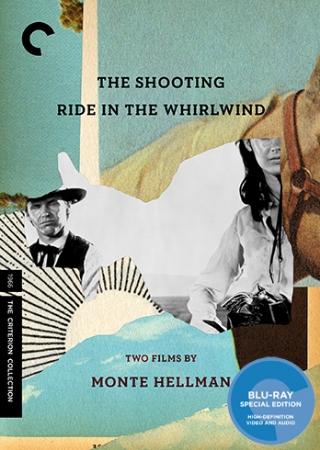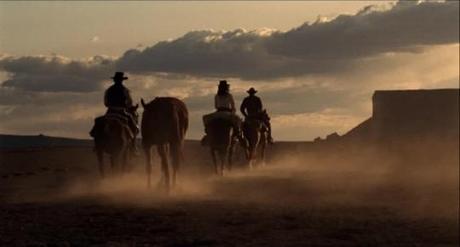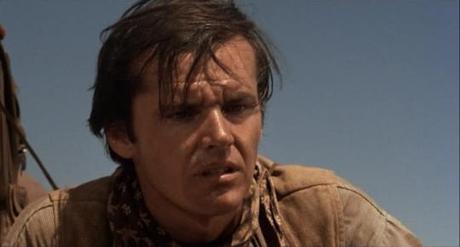
Films naturally reflect the times in which they are made, there’s no getting away from that. As an art form they of course focus on certain themes, frequently timeless ones at that, but there’s no divorcing the artistic ambition from the current circumstances. The western is particularly interesting in this respect as it uses a historical setting and period tropes to comment on a current situation. The Shooting and Ride in the Whirlwind, made back to back in 1966 by Monte Hellman, are a good illustration of this. Here are two films which could not have been made at another time; the mood and aesthetic are firmly rooted in the mid-60s, and in cinematic terms they look back to the classic era of the genre while also pressing forward and moving it in another direction. I see them as slotting in at the end of the genre’s transitional period, making them fascinating both historically and as an absorbing film experience in their own right.
The Shooting is as minimalist as they come with attention centered on just four people – Gashade (Warren Oates), Coley (Will Hutchins), Billy Spear (Jack Nicholson) and an unnamed woman (Millie Perkins). What’s more, precious little is revealed about the backgrounds of any of these characters; Gashade is referred to as having worked as a bounty hunter at one point, but that’s about it. Anyway, it matches perfectly the abrupt sparseness of the tale and the filmmaking style. As viewers we seem to arrive somewhere in the middle of the story, the events leading up to it being explained through a brisk flashback and the ongoing development of the narrative. In brief, the woman turns up and hires Gashade and Coley to lead her through the wilderness, without divulging exactly why she wants to travel or why she wants these men to accompany her. It gradually becomes clear that the events depicted in the flashback have a significant bearing on the woman’s motives, and then there’s the mysterious figure who follows all the way from a discreet distance. If anything, the lack of information and the way subtle hints are dropped as we go along cranks up the suspense. The film is virtually the antithesis of many current productions, where exposition seems to rule and everything has to be slavishly spelled out to audiences. By the time the startling conclusion rolls round almost as many questions have been raised as have been answered, yet the viewer is always treated as an intelligent adult capable of reading things in his or her own way.
Ride in the Whirlwind uses a more conventional narrative structure, and a slightly expanded cast, but it’s another pared down and deceptively simple piece of cinema. Once again no time is wasted in getting to the heart of the matter – a botched stagecoach robbery opens the movie in dramatic fashion and sets up the unfortunate circumstances into which three men will blindly stumble. Vern (Cameron Mitchell), Wes (Jack Nicholson) and Otis (Tom Filer) are cowhands heading back to Texas who unwittingly come upon the outlaw’s hideout. Sensing something amiss, they plan to ride on the following morning but everything goes awry when a trigger-happy posse shows up. As is the case in The Shooting, events overtake the men and force them into a situation where they have little control of their fate. In a sense this film offers a reversal of perspective; where The Shooting follows the action from the hunters’ point of view, Ride in the Whirlwind lets us see it all develop from the side of the hunted. There’s suspense too, but of a different kind – there’s no particular mystery to unravel and the motivation of all concerned is much more clear-cut and easily defined – as a tense struggle for survival ensues.

Aside from the common contributors – Hellman, Nicholson, Perkins and cinematographer Gregory Sandor in particular – both films are fatalistic, existentialist pursuit dramas. The characters are abruptly and without warning pitched into violent and desperate situations which they are powerless to avoid yet are also committed to seeing them through to the bitter end. There’s an authenticity there too in the spare, clipped dialog. And then there are the Utah locations: barren, harsh and dusty, a remote and hostile environment where the human tragedies are played out and the land itself poses a physical challenge. So much of the imagery captured by Hellman and Sandor harks back to the classic westerns of the previous decade while the editing and oblique storytelling style is very much a product of the turbulent mid-60s, in fact it’s arguably ahead of its time. Anyone familiar with westerns will find countless nods to the films that went before and laid the groundwork – the dogged pursuit of the wrong men (The Ox-Bow Incident & The Bravados), the deliberate crippling of a gunfighter’s hand (The Man from Laramie, No Name on the Bullet, One-Eyed Jacks), the burning of the shack to flush out the occupants (Red Sundown), the sudden revelation of the hunter and his quarry’s identities (Winchester ’73) and so on. These are motifs that would crop up again in the future of course, attesting to the influential character of the films.
However, there are other factors which mark these productions out as being of their own era, and as forward-looking works too. For me anyway, a clear shift in tone has taken place. The late 40s and on into the 50s saw the world faced with its fair share of difficulty and uncertainty. Still, the aftermath of the Kennedy assassination and the massive social and cultural changes that were becoming apparent in the mid-1960s represented something totally different. Old certainties were being swept aside and consigned to a past that suddenly seemed very distant. Something new and, as is always the case when abrupt change occurs, vaguely unsettling was on its way; Hellman’s pair of westerns are a cinematic reflection of that sense of bewilderment and confusion.
And then there’s the matter of redemption, the mainstay of the genre throughout its golden years but something which would become increasingly rare with the passage of time. Gashade in The Shooting could be said to be on a redemptive quest, essentially chasing himself, or at least the darker side of himself, and perhaps achieving his goal in the end. I find it difficult to see how anyone else in that movie could be perceived in such terms though, and it just doesn’t apply at all in Ride in the Whirlwind. Therefore the altered emphasis in the western is more readily apparent in Hellman’s movies than was the case in other, earlier transitional works. The predominant feeling one comes away with, which is in marked contrast to what was to be found in the genre only a few years before, is ambiguity. While the true villains are easily identified, there’s a blurring or lack of definition when it comes to the heroes. Gashade’s inaction (albeit reluctant) effectively seals Coley’s fate and his subsequent assault on Spear could be seen as sentencing a man like that to certain death rather than genuinely sparing him. Similarly, when Vern and Wes break away from the homestead in Ride in the Whirlwind they cross a line ethically. The westerns that would follow, and not just the more nihilistic spaghetti variant, mostly saw the replacement of the hero with the anti-hero; a figure whom the audience could be asked to identify with but rarely admire, a figure whose moral plane was frequently only a degree or two above that of the villains.

Frankly, these films always looked a little rough any time I’d seen them in the past on any home video format. I’m delighted to say though that the new release by Criterion, available on both DVD and Blu-ray, sees them looking exceptionally fine. Both titles have undergone 4K restorations with the blessing of the director and the results are very pleasing. There’s plenty of detail in the image and the colors are rich and natural, really showing off the starkly beautiful Utah locations. As usual with Criterion releases there’s a wealth of solid extra features offered: the booklet has an essay by Michael Atkinson, and the disc has interviews with various members of the cast and crew. Kim Morgan provides a video essay on Warren Oates, and there’s a conversation between Will Hutchins and Jake Perlin. On top of all that, both movies have commentary tracks with Monte Hellman, Blake Lucas and Bill Krohn, which are relaxed, entertaining and informative. Overall, it’s an excellent package with the two films looking better than I’ve ever seen them.
These are two fine westerns, entertaining, thoughtful, and made by a man who understood the genre. Furthermore, they’re important movies in the evolution of the western, adding another link to the chain which runs from the silent era right up to the present day. I suppose Ride in the Whirlwind would be the more accessible of the two for viewers unfamiliar with Hellman’s work, but both really are essential viewing for anyone with a taste for intelligent and original filmmaking. I highly recommend them.
My thanks to the people at The Criterion Collection for making this review possible.


COMMENTS ( 1 )
posted on 18 August at 12:32
I am now not certain where you're getting your info, but good topic. I must spend a while learning much more or figuring out more. Thanks for great information I used to be looking for this info for my mission.